With my preliminary sketches complete, I start by painting in the shadows. I will go back and refine the shadows, but this is a good way for me to establish the figure. The light source is bright sun, situated high in the sky, but casting its light on the gryphon's back. I have to keep in mind how each object will cast shadows, such as the banners on the trees, and the wings of the gryphon.
I use a mixture of dioxazine violet and sepia for the feathers, and a mixture of Payne's gray and sepia for the trees and stones. The shadows of the columns are a combination of ultramarine violet and raw umber, mixed with a little white gouache. I also put down a light wash to give the grass some shadow, to avoid flatness when I add color later.
First Washes
For the primary and secondary feathers, I mix ultramarine violet, sepia, and just a touch of ultramarine blue. At this point, my main focus is to get a smooth was over everything - I'll go back later and work on shadows and details. The grass is a wet-on-wet combination of green gold, sap green and viridian, with ultramarine violet in the shadows. I went back to give the columns some more definition, with a raw umber/white gouache wash, and more ultramarine violet/raw umber/white gouache for the shadows.
White gouache allows me to keep a color smooth and 'milky'. This is especially helpful for very low-opacity colors, or colors that granulate. Certain blues, for example, will look blotchy no matter how careful you are, and that's just the nature of the pigment. For the background, I'm careful to use just a little pigment with white gouache, to keep the illusion of atmospheric perspective. This is likely as dark as I will go with the background, with just a few details added later.
Building up Color
I notice the shadows are a bit lacking (particularly on the ground under the gryphon) so I begin to build them up. It's important to keep an eye on your contrast and how dark you're pushing your pigments. With watercolor, it's always easier to go from light to dark, instead of trying to lighten after you've gone too dark. You might think that white gouache, for example, can fix that, but white gouache often fails to get a section as light as if you simply used a light watercolor wash! White gouache will never be as light as the paper.The shadows on the ground are mostly a combination of ultramarine violet and sepia, with some Payne's gray (a blueish gray) closer to the gryphon's paws. Since the sun is so bright, the shadows will be darker and sharper closer to the gryphon's limbs, and fade as they go out.
The next post will look at the rest of the process, and include the final painting.




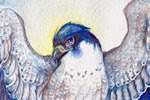
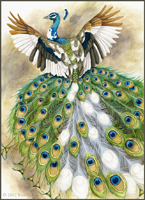
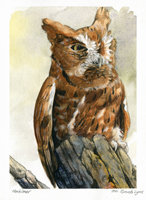
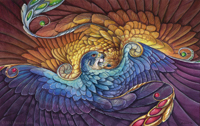
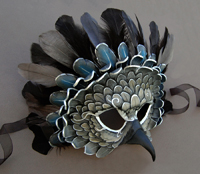
No comments:
Post a Comment